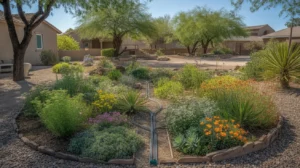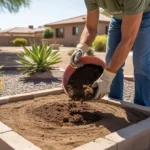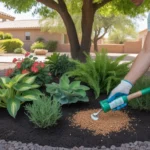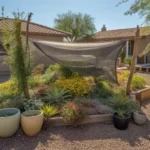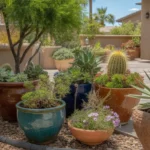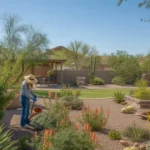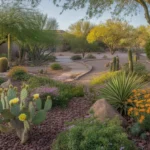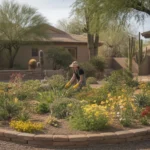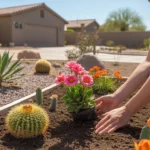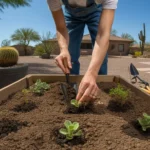As spring arrives in the Southeast Valley, it’s the perfect time to refresh your yard and garden. With our unique desert climate, spring is a key season for planting, pruning, and preparing your landscape for the intense summer ahead. Whether you’re an experienced gardener or just starting out, these spring gardening ideas will help you create a thriving, beautiful yard in cities like Gilbert, Chandler, and Queen Creek.
Amend Your Soil for Optimal Plant Health
Healthy soil is the foundation of any successful garden. In the Southeast Valley, our native soil tends to be heavy in clay and low in organic matter. Before planting, it’s crucial to amend your soil to improve drainage and provide nutrients for your plants.
Start by adding generous amounts of compost, which is decomposed organic matter that enriches soil. You can make your own compost from yard waste and kitchen scraps, or purchase bags from a local nursery. Mix several inches of compost into the top 12 inches of soil. For extra drainage, consider blending in coarse sand or perlite, a lightweight volcanic rock.
Well-amended soil allows roots to establish quickly, retains moisture, and provides a slow-release of nutrients. Your spring plants will be off to a strong start and better equipped to handle the summer heat.
Choose Desert-Adapted Plants for Spring Color
Spring is the ideal time to add colorful annuals and perennials to your Southeast Valley yard. With our arid climate and intense sun, it’s important to select plants that are adapted to desert conditions. These hardy species can handle the heat with minimal water and care.
For vibrant blooms, plant penstemons, also known as beardtongues. These spiky flowers come in shades of pink, purple, and red, and attract hummingbirds. Desert marigold is another spring favorite, with sunny yellow flowers that light up the landscape. For a carpet of color, try moss rose, a low-growing annual with red, pink, or white cup-shaped blooms.
To add texture and interest, incorporate desert-adapted succulents like paddle plant, parry’s agave, and desert spoon. These sculptural plants store water in their thick leaves, allowing them to sail through dry spells. With their striking forms and low-water needs, succulents make excellent focal points.
Install a Drip Irrigation System
Conserving water is always a priority in the Southeast Valley, and drip irrigation is one of the most efficient ways to hydrate your spring garden. Unlike sprinklers that spray water into the air, drip systems deliver moisture directly to the roots of plants through flexible tubing and emitters.
Drip irrigation minimizes evaporation and runoff, so plants receive a slow, steady supply of water. You can easily customize the layout to target specific plants or garden beds. Hook the system up to an automatic timer and you’ll be able to water on a consistent schedule with minimal effort.
When planning your drip layout, use emitters for larger individual plants, micro-sprays for groundcovers and containers, and inline drip tubing for rows of plants. With precise watering, your spring garden will thrive without wasting our precious water resources.
Refresh Your Mulch for Healthier Plants
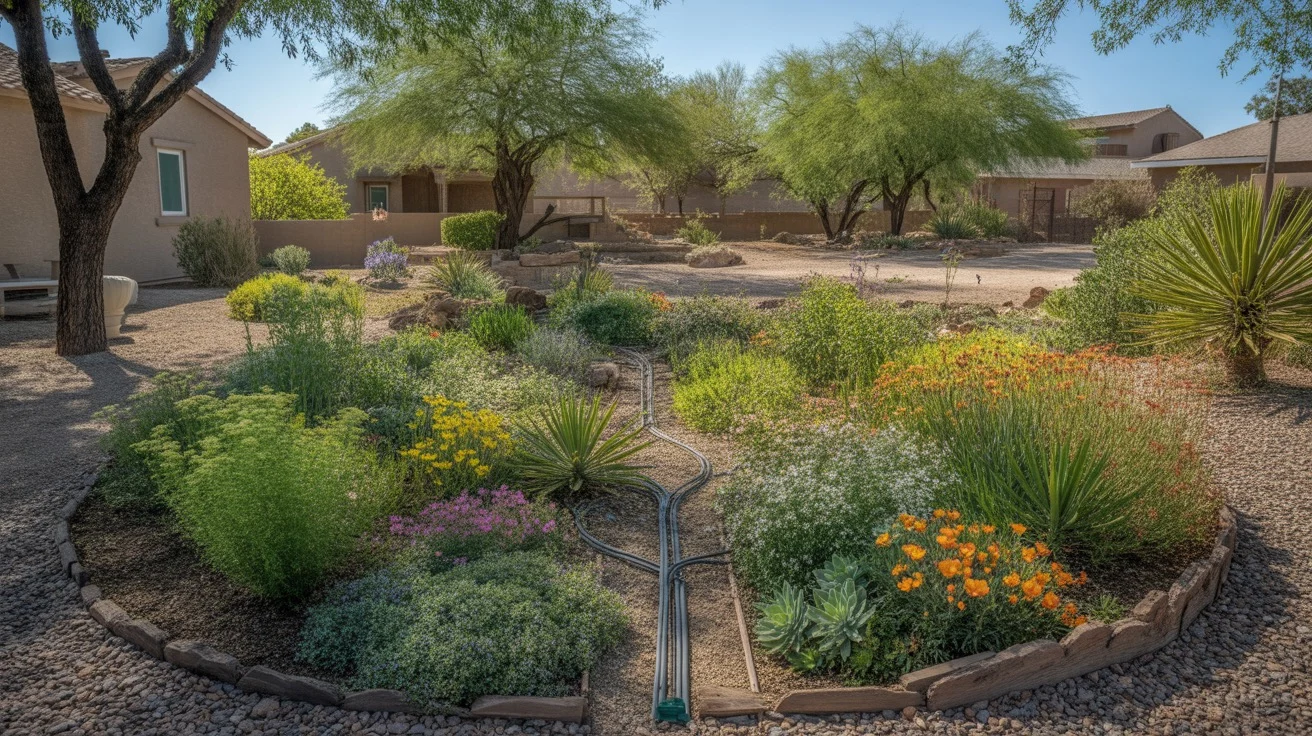
Adding a fresh layer of mulch is one of the easiest and most effective ways to nurture your spring garden. Mulch is any material spread over the soil surface, such as bark chips, straw, or gravel. A 3-4 inch layer of organic mulch offers multiple benefits for your Southeast Valley yard.
As mulch breaks down, it adds nutrients and improves soil structure. It also helps retain moisture by slowing evaporation, which means you’ll water less frequently. Mulch keeps the soil cooler, protecting plant roots from intense heat. By suppressing weed growth, a thick mulch layer saves you time and effort.
For a desert-friendly look, use inorganic mulches like pea gravel or crushed rock. These materials don’t break down, so they’re excellent for covering large areas and creating tidy pathways. For garden beds, stick with shredded bark or straw to enrich the soil as it decomposes.
Prune and Tidy for Healthy New Growth
Spring is the time to tidy up your yard and prepare plants for a burst of new growth. Start by removing any dead, damaged, or diseased branches from trees and shrubs. Use clean, sharp pruning tools to avoid injuring the plant.
Prune desert trees like mesquite, palo verde, and acacia while they’re still dormant in early spring. Wait to prune frost-tender plants like bougainvillea and lantana until after the last average frost date, typically in late February in the Southeast Valley. Avoid pruning in the heat of summer when plants are stressed.
Spring is also a good time to divide mature perennials like daylilies, iris, and salvia. Dig up overgrown clumps, separate the roots, and replant the divisions to rejuvenate the plant and create new specimens for your garden. Regular pruning and dividing will keep your plants healthy and vigorous year after year.
Plant a Herb Garden for Fresh Flavors
Enjoy the taste of fresh herbs by planting a kitchen garden this spring. Many herbs thrive in the Southeast Valley’s sunny climate and well-drained soil. Herbs make attractive, fragrant additions to the landscape and provide a ready supply of flavorings for cooking.
Mediterranean herbs like rosemary, thyme, oregano, and sage are especially well-suited to our region. These drought-tolerant plants have small, aromatic leaves that stand up to intense sun and heat. Plant them near pathways or in containers to enjoy the scent as you brush past.
Basil is another must-have herb for the spring garden. Wait until the soil warms up to plant this heat-lover, then enjoy a bumper crop all summer long. Pinch off the flower buds to encourage bushier growth and a continuous harvest. With an abundant herb garden, you’ll add fresh, homegrown flavor to your favorite dishes.
Invite Pollinators with a Wildflower Patch
Create a colorful oasis for bees, butterflies, and other pollinators by planting a wildflower garden this spring. Pollinators are essential for healthy ecosystems and productive vegetable gardens, but their populations are declining due to habitat loss and pesticide use. By dedicating a patch of your yard to native wildflowers, you’ll provide food and shelter for these vital creatures.
Choose a sunny spot with well-drained soil and scatter a mix of native wildflower seeds. Look for blends that include desert bluebells, California poppies, desert lupine, and Mexican gold poppies. These hardy annuals will bloom in a rainbow of colors and reseed themselves for years of low-maintenance beauty.
To maintain your wildflower patch, water deeply but infrequently to encourage strong roots. Avoid using pesticides or herbicides that can harm pollinators. At the end of the season, let the flowers go to seed to ensure a bountiful display next spring. Your pollinator garden will buzz with life and color.
By trying these spring gardening ideas, you’ll create a vibrant, water-wise landscape that’s perfectly in tune with the Southeast Valley’s unique climate. Whether you’re planting colorful blooms, refreshing your mulch, or inviting pollinators, your efforts will pay off in a healthy, beautiful yard that thrives through spring and beyond. So grab your tools, amend your soil, and enjoy the satisfying process of nurturing life in the desert.

